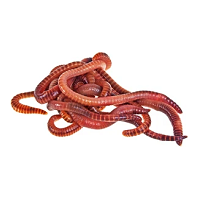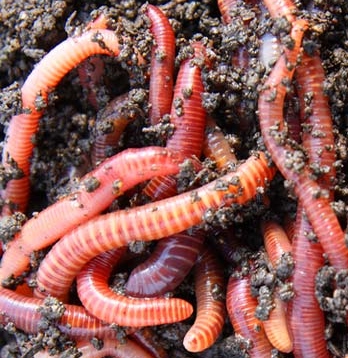The Single Strategy To Use For Where To Find Red Wigglers
The Single Strategy To Use For Where To Find Red Wigglers
Blog Article
Getting My Where To Find Red Wigglers To Work
Table of ContentsThe smart Trick of Where To Find Red Wigglers That Nobody is Talking AboutExcitement About Where To Find Red WigglersFascination About Where To Find Red WigglersThe 7-Minute Rule for Where To Find Red WigglersThe smart Trick of Where To Find Red Wigglers That Nobody is Talking AboutThe Facts About Where To Find Red Wigglers Revealed
For finest outcomes, you intend to strive concerning 60-70% wetness degree. The simplest test for this is to press a handful as hard as you can. At the excellent wetness degrees which is simply under 70% that handful should barely generate one decrease of fluid. pH in a worm container is quite very easy to preserve.
The Indian Blue is starved, however also chooses a warmer climate and it additionally exhibits a tendency to get away the container. The red wiggler is a sturdy worm and isn't as fussy regarding its climate. I such as to call it the Ford Taurus of vermicomposting worms; you will not boast to your hardcore composting buddies that you possess them, but they will certainly offer you well.
Like any various other lure, a worm's performance has actually pertained to depend upon its discussion. H.G. "Tap" Tapply highlighted this factor nearly a half century ago in one of his Field & Stream columns. "A worm is such a shapeless creature," he wrote, "there does not appear to be quite an angler can do with it other than jab it on a hook and toss it into the water." Yet as Tap showed, a fishermen can do a bargain to make a worm a lot more enticing.
All About Where To Find Red Wigglers
I believe you will certainly too if you try them. The smaller sized the trout stream, the far better worms job is an axiom that hasn't changed in the 100-plus years because Perry wrote his short article. Anglers of his age simply stuck their weak fishing pole via alder tangles and went down a heavy worm into a deep hole.
Morning is prime feeding time, and the insubstantial bait's slow-moving descent leaves 5 inches of squirming protein completely sight for a long time. After you've made the cast, keep the bond open and put the rod in a forked stick. The line will certainly diminish the rod in slow loopholes as the worm works out, but usually the slow loopholes will certainly come to be a blur, and the early morning will instantly get rather intriguing.
I normally use an entire 'crawler, favor marabou dressing, and go down the rod for two or three seconds when I obtain a hit.
And differentiating base from a bite can be hard. The method is to ease the rod back to the strike (perhaps a foot) and feel for life at the end of the tightening line. If it's there, set the hook with a move instead of a jerk. Every so often you'll find yourself hooked to those sluggish, hearty pulls, and feel the weight of a nice walleye.
The Main Principles Of Where To Find Red Wigglers
When the heavy walleyes go on to the big-water shoals in the late summer season, attempt pursuing them with a bucktail jig and a 1-inch pinch of nightcrawler. The bait covers the hook point, disperses weeds, and offers a taste of prey. With nothing dangling or flapping, it stays safe regardless of existing, casts, or enthusiastic panfish.
Whether you're wading or fishing from a watercraft, wandering worms is one of the fantastic looking approaches for larger rivers. For trout, a spade-dug, 4-inch garden worm is the right size; for bass, walleyes, and steelhead, a nightcrawler might be a much better choice. The secret is to drift the lure through feeding and holding locations due to the fact that fish in present are not mosting likely to chase down the bait, as they might in still water.
Fish the transitions: mouths of tributaries, bank-side slicks, and the sides of large pools. His dictum uses to any type of number of angling maneuvers, consisting of the matter of including a piece of worm to a damp fly.

Where To Find Red Wigglers Things To Know Before You Buy
Load it with shredded newspaper, leaves, peat moss, and dirt. Moisten gently. Cover and let rest for a week. Add view website a couple of hundred worms and feed them 2 times a week. Keep the bed linens wet but not wet. On the food selection: lettuce, vegetables from this source and fruit waste, and the occasional nongreasy leftover.
Simply like veggie scraps, you can take your utilized coffee premises and include them to a worm box. Worms enjoy eating coffee grounds.
When the hefty walleyes carry on to the big-water shoals in the late summer season, attempt pursuing them with a bucktail jig and a 1-inch pinch of nightcrawler. The lure covers the hook factor, deflects weeds, and provides a taste of victim. With absolutely nothing dangling or flapping, it continues to be safe and secure despite existing, casts, or enthusiastic panfish.
How Where To Find Red Wigglers can Save You Time, Stress, and Money.
Whether you're wading or angling from a boat, wandering worms is one of the great browsing strategies for larger rivers. Where To Find Red Wigglers. For trout, a spade-dug, 4-inch yard worm is the appropriate dimension; for bass, walleyes, and steelhead, a nightcrawler might be a better choice. The key is to wander the bait via feeding and holding areas since fish in current are not going to chase after down the bait, as they might in still water
Fish the transitions: mouths of tributaries, bank-side slicks, and the edges of large swimming pools. His rule uses to any kind of number of angling maneuvers, including the matter of including an item of worm to a damp fly.
However elevating your own bait suggests you can unclothe your home and struck the pond prior to Mother comes homejust like in the old days. Here's how to keep a worm box: Cut a sheet of CDX-grade plywood, which is made with water-resistant adhesives, to your dimensions. Toenail it together and drill a loads 12-inch openings in the base for water drainage.
Indicators on Where To Find Red Wigglers You Should Know
Include a few hundred worms and feed them two times a week. Keep the bed linen damp but not damp. On the menu: lettuce, fruit and veggie waste, and the occasional nongreasy extra (Where To Find Red Wigglers).
Simply company website like veggie scraps, you can take your used coffee premises and add them to a worm box. Worms enjoy consuming coffee grounds.
Report this page